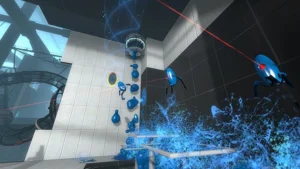For my critical play, I took an in-depth look at two games that were a huge part of my childhood: Valve’s Portal series. Comprising of Portal (2007) and Portal 2 (2011), these games blend innovative puzzle mechanics with a rich storyline. By examining how these mechanics influence the overall experience, we can see what elevates them above other games in the genre. Through clever level design, engaging dialogue, and seamless narrative integration, the Portal series turns simple puzzles into a masterful exploration of critical thinking and storytelling. The series uses its unique mechanics to challenge players intellectually while immersing them in a narrative that critiques institutional control and humanizes artificial intelligence. This dual focus sets Portal apart, creating a memorable and replayable experience.
The core mechanic of the Portal series is the portal gun, which allows players to create interconnected portals on flat surfaces. This simple yet profound tool forms the basis for increasingly complex puzzles that require spatial and logical thinking. The portal gun’s functionality establishes clear boundaries and possibilities within the game world. The dynamics created involve experimenting with momentum and spatial orientation to solve puzzles, engaging critical thinking and problem-solving skills.
In Portal, the narrative unfolds through GLaDOS, an AI antagonist who guides and manipulates the player. The interplay between GLaDOS’s commands and the player’s actions creates a dynamic where the puzzles become a medium for narrative expression. This is an example of embedded narrative, where story elements are integrated into the game mechanics and environment, making the player’s journey through the puzzles also a journey through the story. Portal 2 expands the mechanics with new elements like gels that alter surfaces, excursion funnels that manipulate gravity, and thermal discouragement beams that redirect lasers. These additions deepen the puzzle-solving experience, encouraging players to approach problems from multiple angles. This introduces emergent gameplay, where the interaction of game systems and player actions can produce complex and unpredictable outcomes, enhancing replayability and engagement.

The Portal series gradually introduces players to its mechanics, ensuring a smooth learning curve that keeps them engaged without overwhelming them. Early levels control portal placement, teaching navigation and basic mechanics. As players progress, they gain more control, allowing for more complex problem-solving and deeper engagement. This mirrors game design theories on scaffolding, where players get initial support that gradually removes as they become more proficient.
Visual hints and environmental cues play a significant role in guiding players through the puzzles. Arrows and distinctive markings help players identify potential portal surfaces and critical points. These aids are essential for maintaining game flow, preventing frustration and disengagement.
Compared to other puzzle games like The Witness or Baba Is You, Portal stands out for its seamless integration of narrative and mechanics. While The Witness focuses on visual puzzles and exploration, and Baba Is You emphasizes word-based logic puzzles, Portal’s strength lies in making mechanics an intrinsic part of the storytelling. This unique approach sets a high standard for narrative-driven puzzle games.
Players use various strategies to solve puzzles, including trial and error, repetition, and stopping to think. From class and readings on game architecture, we know these “mini-loops” are crucial for creating player engagement and that “hooked” feeling. These strategies highlight the importance of game design in supporting player learning and problem-solving. For example, visual cues like red lights indicating where to place portals help players overcome obstacles. When these cues aren’t clear enough, players may struggle, indicating areas for potential improvement.
The Portal series masterfully balances puzzle mechanics with a compelling narrative, creating an immersive and intellectually stimulating experience. By analyzing the design concepts and mechanics of these games, I gained a deeper understanding of how they influence player engagement and emotional investment. Portal challenges players to think critically while telling a story that critiques institutional control and explores AI, which explains why I enjoyed the games so much when I was younger!




